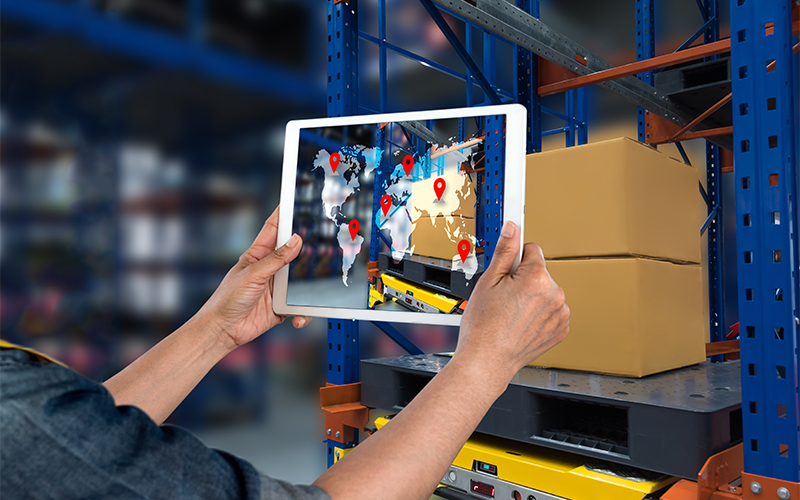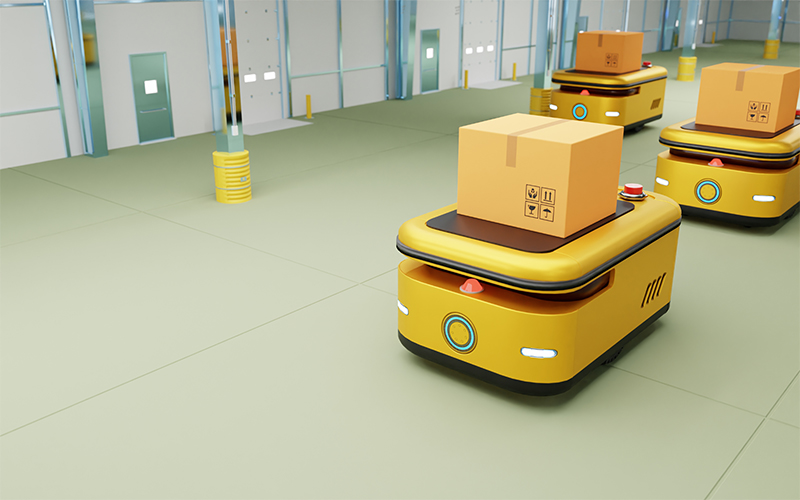Supply Chain
IoT in Supply Chain Management: The Ultimate Guide
Consider a warehouse that handles a few thousand products for an e-commerce company. The warehouse leverages data from its (internet-of-things) IoT devices that automatically track the quantity of each product and raise an alert or automatically place an order to replenish the stock once it falls below the defined threshold. That is just one of the many transformations IoT can bring in managing supply chain and logistics.*
Some examples of companies successfully leveraging the power of IoT are Amazon, Volvo, and Nissan Motor Co. Volvo uses IoT supply chain to track its vehicles’ components from several countries and vehicle deliveries to its global customers. Nissan uses IoT supply chain to link its multiple industrial units. Amazon has been using a fleet of IoT-enabled robots for warehouse management operations by scanning the QR code on packages. The role of IoT in supply chain management is vital for a business to grow. Let’s look at a few benefits and challenges of IoT in supply chain management and its impact on inventory management.
What is IoT in Supply Chain Management?
IoT in supply chain management refers to the network of physical assets—such as vehicles, pallets, and individual products—that are embedded with sensors, software, and other technologies to connect and exchange data over the internet. This allows for unprecedented visibility, control, and automation across the entire supply chain. Some examples of companies successfully leveraging IoT are Amazon, which uses robots for smart warehouse management, and Volvo, which uses IoT to track vehicle components and deliveries across the globe.
Key benefits of IoT in supply chain management
The COVID-19 pandemic and the subsequent global geopolitical events have demonstrated that supply chains are not as resilient as one might have assumed. As goods travel larger distances and exchange more hands, there are more chances of disruptions in the supply chain operations. In such a scenario, (IoT) internet of things can help businesses in managing such unprecedented situations.
Track real-time location:
IoT devices can help you track the position of goods at all times, be it inside a large warehouse or on a ship. If you ship the products on a wrong route, the IoT system delivers automatic alerts to fix the problem.
Monitor storage condition:
Many goods are prone to damage from environmental conditions such as humidity, heat, pressure, and cold. IoT devices can gather the environmental data from a warehouse or a truck and automatically adjust the conditions.
Locate goods within the warehouse:
Finding the right product and constantly tracking its quantity in a large warehouse can be difficult. IoT in supply chain management increases efficiency and boosts employee safety. When IoT is used in combination with artificial intelligence (AI), it can fully automate the warehouse with minimal human supervision.
Improve contingency planning:
With IoT and data analytics, managers can predict and plan for contingencies such as traffic, weather, possible accidents, or other delays. Managers can develop flexible contingency plans based on the movement of goods and use real-time alerts to mitigate risks.
Enhance total supply chain performance:
Equipment breakdown can affect the performance of supply chains. IoT sensors used for predictive maintenance can schedule appointments with technicians to proactively fix the machines that handle goods throughout the supply chain.
Better segmentation of goods:
Data from IoT devices can help logistics managers can better segment the goods throughout their life cycle according to their target market or other segmentation parameters in the context of global supply chain. Managers can understand the marketplace better and build relevant strategies in the context of global supply chain.
Challenges of using IoT in supply chain management
A successful implementation of IoT in supply chain management has its own set of challenges, which can be resolved with the right vendor and technology.
Skill gap:
The warehouse staff and vehicle drivers need to be trained and educated about the security practices and the guidelines for using corporate IoT-based supply chain management platforms.
Data storage challenges:
The large pool of data that IoT systems generate is both a benefit and a challenge. There needs to be enough server power to store and process the collected data. In addition, there must be data governance policies to derive the right conclusions.
Security threats:
Before switching to fully connected systems, you need to have a secure IoT architecture. Vulnerabilities in data can result in outside attacks and leaks. By implementing machine learning (ML) and cryptographic hardware monitoring, managers can mitigate security threats.
Connectivity issues:
IoT platforms and devices rely heavily on internet availability and other short distance technologies such as Bluetooth and NFC. As the internet coverage increases and 5G becomes available, this issue will resolve automatically.
5 Real-World Use Cases of IoT in Supply Chain
Beyond simple tracking, IoT enables a wide range of powerful applications:
- Smart Warehousing: IoT-enabled robots, like those used by Amazon, can automate picking, packing, and sorting by scanning QR codes, dramatically increasing fulfillment speed and accuracy.
- Fleet Management: Telematics sensors on trucks and delivery vehicles provide real-time data on location, fuel consumption, engine health, and driver behavior, enabling optimized routing and reduced fuel costs.
- Cold Chain Monitoring: For pharmaceuticals and fresh food, IoT sensors continuously monitor and log temperature and humidity from farm to shelf, ensuring product safety and regulatory compliance.
- Yard Management: In large distribution centers, IoT helps manage the chaotic movement of trailers and containers, tracking their location and status (e.g., loaded, empty) to reduce wait times and optimize loading bay usage.
- Inventory and Asset Tracking: Instead of manual barcode scans, IoT (often using RFID) provides a real-time view of every single asset or pallet in the supply chain, reducing theft and improving stock accuracy.
How to Implement an IoT Solution in Your Supply Chain: A 4-Step Roadmap
Embracing IoT can be done in a phased, strategic manner.
- Identify the Core Problem: Start by identifying the biggest pain point in your supply chain. Is it inventory accuracy? High fuel costs? Spoilage in transit? Focus on a single, high-impact problem first.
- Start with a Pilot Project: Before a full-scale rollout, launch a small pilot program. For example, equip one warehouse or a small portion of your fleet with IoT sensors to test the technology and measure the ROI.
- Choose the Right Technology Partner: Select a partner who not only provides the hardware but also offers a scalable cloud platform for data management and analytics, and has deep expertise in supply chain processes.
- Develop a Change Management Plan: Train your team not just on how to use the new tools, but on how to use the new data to make smarter, faster decisions.
How Infosys BPM Transforms Your Supply Chain with IoT
Infosys BPM partners with organisations to streamline and digitise their supply chains using IoT technologies. The end-to-end solutions across consulting, technology intervention, and managed services help run supply chain planning as a service. We focus on delivering tangible outcomes:
- Supply Chain Diagnostics to find your biggest opportunities.
- A "Control Tower" approach for end-to-end visibility.
- Forecasting as a Service powered by real-time data.
- AI-driven inventory optimization.
View our supply chain optimisation services and start your transformation today.
*For organisations on the digital transformation journey, agility is key in responding to a rapidly changing technology and business landscape. Now more than ever, it is crucial to deliver and exceed on organisational expectations with a robust digital mindset backed by innovation. Enabling businesses to sense, learn, respond, and evolve like a living organism, will be imperative for business excellence going forward. A comprehensive, yet modular suite of services is doing exactly that. Equipping organisations with intuitive decision-making automatically at scale, actionable insights based on real-time solutions, anytime/anywhere experience, and in-depth data visibility across functions leading to hyper-productivity, Live Enterprise is building connected organisations that are innovating collaboratively for the future.
Frequently Asked Questions (FAQ)
What is the difference between IoT and RFID in supply chains?
RFID is a technology used for identification and is a component of IoT. An RFID tag is a simple tag that can be read at a distance. An IoT system, however, includes the RFID tags plus the sensors, the network, and the software platform to collect, analyze, and act on that data.
What is the typical ROI for an IoT project in logistics?
The ROI can be significant, but it varies based on the use case. For fleet management, ROI often comes from reduced fuel and maintenance costs (10-20%). For inventory management , it comes from reduced stockouts and carrying costs. A good pilot project will help you calculate the specific ROI for your business.
How does IoT improve inventory management in supply chains?
IoT enhances inventory management by providing real-time tracking of stock levels, automating reordering, and reducing errors through sensors and AI integration, leading to lower holding costs and fewer stockouts.
What are the costs associated with implementing IoT in supply chain management?
Initial costs include hardware (sensors, devices), software integration, and training. Ongoing expenses cover data storage and maintenance, but ROI typically offsets these within 1-2 years through efficiency gains.
What future trends should we watch for in IoT for supply chains?
Key trends include integration with 5G for faster data transfer, AI/ML for predictive analytics, blockchain for enhanced security, and edge computing for real-time processing at the source.







